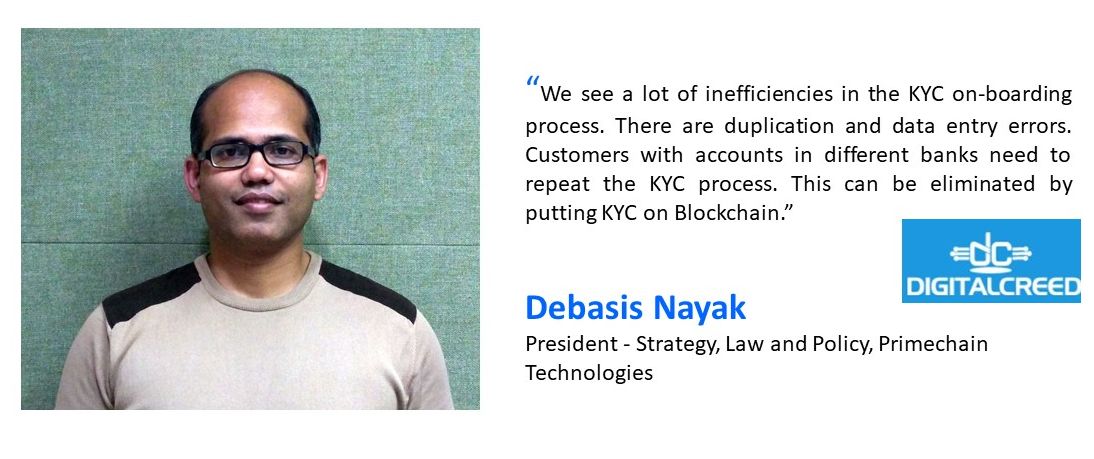Pundits predict that 2018 is going to be the year of Blockchain. It has caught the attention of banks and financial services companies in India, who are now moving beyond the proof-of-concept stage and are testing Blockchain applications.
Primechain Technologies has created BankChain, a blockchain that includes 30 banks and money transfer services. The State Bank of India is using Primechain’s blockchain-enabled smart contracts and KYC.
Digital Creed met Debasis Nayak, President – Strategy, Law and Policy, Primechain Technologies to discuss BankChain and other useful Blockchain applications.
DC: Can you tell us about a tried and tested Blockchain application?
Debasis Nayak: A great example of Blockchain usage is remittances. Indians working overseas who send money home, encounter a complicated process of inter-bank transfers. The transaction costs are also high. The employer’s bank usually does not have a settlement bank in India. Therefore, it needs to use an intermediary bank that has accounts at both locations. You need to have an Escrow account. Money transfer services are an alternative, though they have a limitation on the amount.
With Blockchain, you share nodes across banks and jurisdictions; the distribution of the transactions occurs in real-time across all nodes in the chain. There is no need to reconcile the information at the end of the day, and there are no intermediaries involved in the settlement. Transactions are tokenised since it is an internal system, like Bitcoin cryptocurrency. It is a closed system. The regulator also receives a note about the transaction.

DC: Could SWIFT also do a Blockchain in future?
Debasis Nayak: SWIFT does not use Blockchain, but it may eventually have its system of distributed ledgers. For instance, R3 has come out with Corda, a distributed ledger designed for financial services.
It takes a long time to complete a transaction on the SWIFT system, and there are intermediary fees.
Editor: SWIFT does not facilitate remittances. It is a messaging system that sends payment orders that prompt correspondent accounts to complete a settlement.
DC: What is BankChain all about and what kind of challenges does it solve?
Debasis Nayak: We are trying to solve a regulatory challenge with BankChain. If ten banks need to be part of the same Blockchain, there needs to be some uniformity in regulations. There needs to be a common framework to govern the transactions between those banks.
We are now offering BankChain, which has 30 members including almost all the major banks in India. It includes some banks in the Middle East and some money transfer operators. They all came together on a common platform to test what Blockchain applications can do for them. This itself tells us that there is an interest in sharing information.
We develop the applications for the 30 banks.
Additionally, we also offer PrimeChain Contract, a contract management system. We have pushed the contracts into the Blockchain itself. It enables multiple signatures (in the contract).
DC: What could be an immediate application for BankChain?
Debasis Nayak: We see a lot of inefficiencies in the KYC on-boarding process. There are duplication and data entry errors. We can eliminate these errors by avoiding duplication. Customers with accounts in different banks need to repeat the KYC process. Currently, customers submit the same set of documents to different banks, redundantly. This can be eliminated by putting KYC on Blockchain.
If banks are part of a Blockchain, they can share KYC data, eliminating the need for customers to repeat the KYC process.
DC: What kind of security features does BankChain have?
Debasis Nayak: Blockchain is based on hashing so it is inherently secure. Because of hashing, it is impossible to derive the input from the output. But a customer does not connect to the Blockchain directly, in a sense, he does not know what is happening in the backend. If there is a security risk, it lies in the front-end that you are using – the API or the application that sits on top of the Blockchain, which extracts information from it. That’s where the risk lies.
We have Blockchain security controls (in BankChain) to secure the applications on the Internet: Using a wallet; generating key pay to authenticate a transaction. We need to secure these channels, which can be compromised.
DC: How are you leveraging Microsoft Azure services for BankChain? Why did you choose Azure over AWS?
Debasis Nayak: Today I have 30 banks and multiple nodes on BankChain (each bank could have four nodes). But if that number were to increase to 300 or 3,000 in future, then my infrastructure needs to scale up. The only way to do that is by going to the cloud, and that’s where Azure comes in. We use the Azure cloud services along with its inherent AI capability, which we foresee as being a very integral part of our offering.
Why Azure? Because Microsoft has been moving very fast. Their support system on the cloud (if we have an issue with configuring the cloud according to how we want it) is good, and they are responsive. It is impressive to see an organisation of this size respond with that speed. The response is quick.
Microsoft is building good AI capabilities. For instance, once we start tokenisation of global remittances using Blockchain, it is a closed system of currency, and we want to have a secure system.
For the member banks… we also want to integrate AI capability into the APIs. Depending on how much data is coming in, we want to give them patterns that they will benefit from that data. We want to integrate their AI capabilities into our solution.
The writer was hosted by Microsoft India for Media & Analyst Days 2017, in Hyderabad.









